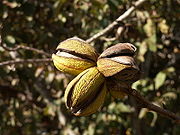
(The Manufacture of Oil drawn and engraved by J Amman in the Sixteenth Century/Wikipedia)
Once again, this morning during my bus ride to work (it’s pouring outside!), I was thinking of my vegan and vegetarian friends and also my omnivore (I’m one of them!) ones. As far as I can recollect, there is little written about oils and I thought I write up a useful posting for all to copy and borrow!
Have you ever wondered how many kinds of oil there are out there?
All right shall we start (and I’m sure to forget some along the way!):
OLIVE OIL

Now, we all seem to know what olive oile is all about.
But there is only one good type of olive oil: Extra Vrigin Olive Oil! That is what comes out first caused by the natural pressure of all these olives piled upon each other.
The rest is sub-standard, whatever the name.
Back in France (and most probably in may other countries) we have olive oil sommeliers/tasters!
have you ever heard of the expressions: fruitiness, bitterness, pungency, and mouth feel.
And I’m not talking about the olives themselves!
I will not tell and hope I got you hooked!
SWEET ALMOND OIL

Almond Oil was used as perfume in ancient times.
Light and very fragrant, it is particularly welcome in marinades (raw salmon seasoned with dill or basil) or drizzled over seafood, pasta or fish prior to serving.
ARGAN OIL

Also called Moroccan Fennel Oil, Argan oil is an oil produced from the kernels of the endemic argan tree, that is valued for its nutritive, cosmetic and numerous medicinal properties. That tree is found only in North Africa.
Bold and wild in taste, it is a favourite of mine. Use it isparingly n salads, couscous and tagines. Works wonders on a beef carpaccio and on goat cheese.
PEANUT and ROASTED PEANUT OIL

Peanuts oil is very common, all right, but roasted peanut has a startling flavour. Perfect for salad and cheese dishes. Suited to all warm climate cuisines: Mexican, African, Indonesian.
CANOLA or RAPE SEED OIL

The Japanese eat the unopened flowers and young shoots after boiling them.
They reveal a full-bodied in taste with a distinct cabbage flavor. Enhances potato or beet salads. Try it on fresh cottage cheese!
HAZLENUT OIL

Another favourite of mine. I use it extensively in salad dressings.
Hazelnuts are rich in protein and unsaturated fat. Moreover, they contain significant amounts of thiamine and vitamin B6, as well as smaller amounts of other B vitamins.
Suave and lightly aromatic. Great in all types of salads. Replaces butter (vegans, listen!) on all starches, vegetables, fish, pasta, pastries. Adds a festive touch when drizzled on a potato, green bean or carrot dish.
WALNUT OIL

Another favourite of mine!
In France we make bread, pickles and liqueurs with them!
Walnuts are also an excellent source of omega-3 fatty acids, and have been shown as helpful in lowering cholesterol.
They have a pronounced nutty flavour. Well suited for bitter greens (endives, chicory, dandelion); excellent drizzled on starches. This oil is a good companion to a lightly seasoned fresh cheese. This oil fears heat!
PECAN NUTOIL

Pecans are a good source of protein and unsaturated fats. A diet rich in nuts can lower the risk of gallstones in women. The antioxidants and plant sterols found in pecans reduce high cholesterol by reducing the “bad” LDL cholesterol levels.
It reveals a pronounced nut taste, in between walnut and almond. Good on any type of rice, cold, hot or in a salad.
GRAPE SEED OIL

Grape seed oil is also a preferred cosmetic ingredient for damaged and stressed tissues!
Neutral taste (it is unscented). Perfect for mixing with other more pungent oils; ideal for deep frying. Grape seed contains potent antioxidants such as vitamin E alpha and procyandanians, which contribute to its numerous health benefits.
PINE NUT OIL

Pine nut oil has a relatively low smoke point, and is therefore not generally used during cooking. Rather, it is added to foods for “finishing”, to add flavor.
It reveals a very subtle and mild taste. Enhances the flavour of any dish on which it is drizzled. Added in the final moments of cooking, it does wonders with seafood stews, sauces (especially wine) and soups (particularly minestrone).
PISTACHIO OIL

In July 2003, the Food and Drug Administration (FDA) approved the first qualified health claim specific to nuts lowering the risk of heart disease.
Its oil has a very distinct, long-lasting taste. It is not suited to all types of vinegars: balsamic and honey are the best. A vinaigrette composed of this oil, balsamic vinegar, chives and seasoning is superb on an endive and smoked trout (or salmon) salad.
SESAME OIL

In Japan, the best tempura is deep-fried in pure sesame oil only!
Used extensivley all over the World, it has a very strong roasted, nutty flavour. A few drops in a salad or stir fry gives the dish a definite oriental touch.
I use it extensively with tofu, natto and salads!
SOY BEAN OIL

Soy bean oil is mainly used as a bulk cooking oil especially in South Asia and in the Middle East.
The most important point regarding the use of soybeans for human nutrition is the absolute necessity to cook the soybean with “wet” heat in order to destroy the trypsin inhibitors; serine protease inhibitors.
Soybeans are considered by many agencies, including the US Food and Drug Administration, to be a source of complete protein.
MUST-SEE WEBSITE:
1001 HUILES (Engish & French)